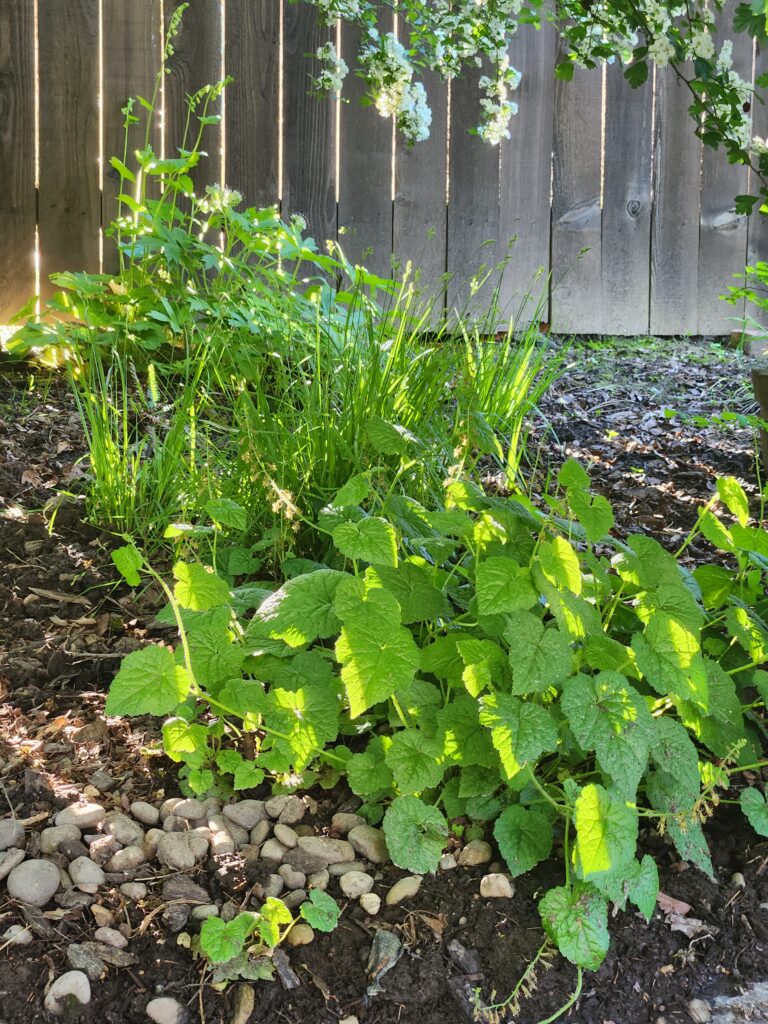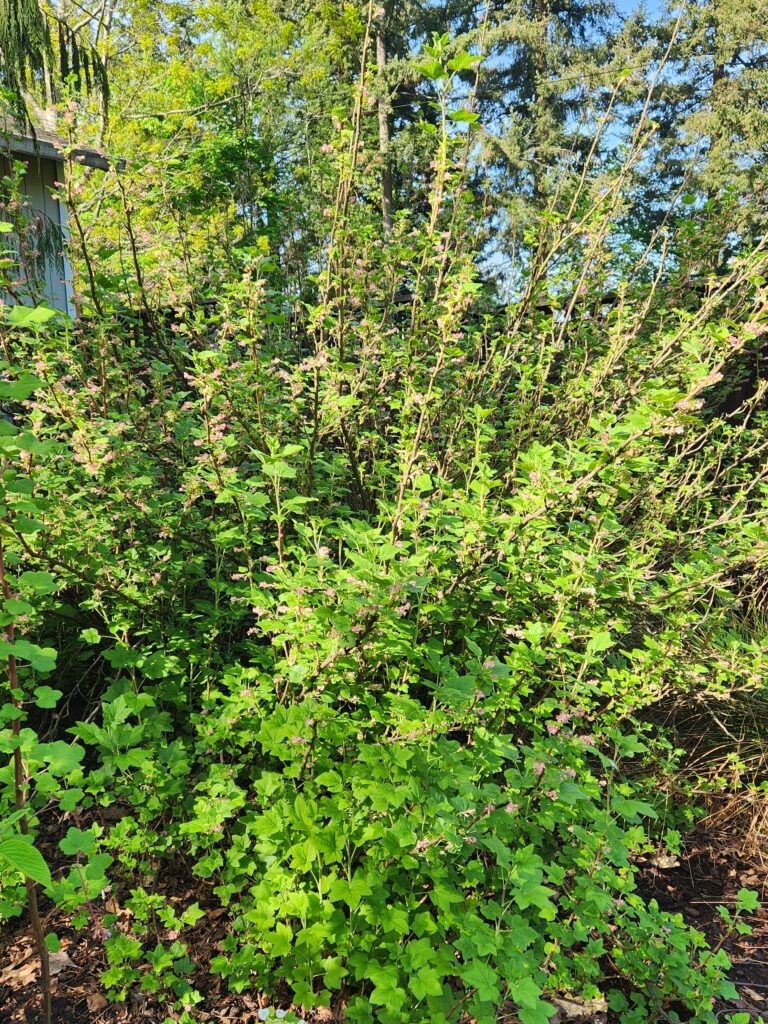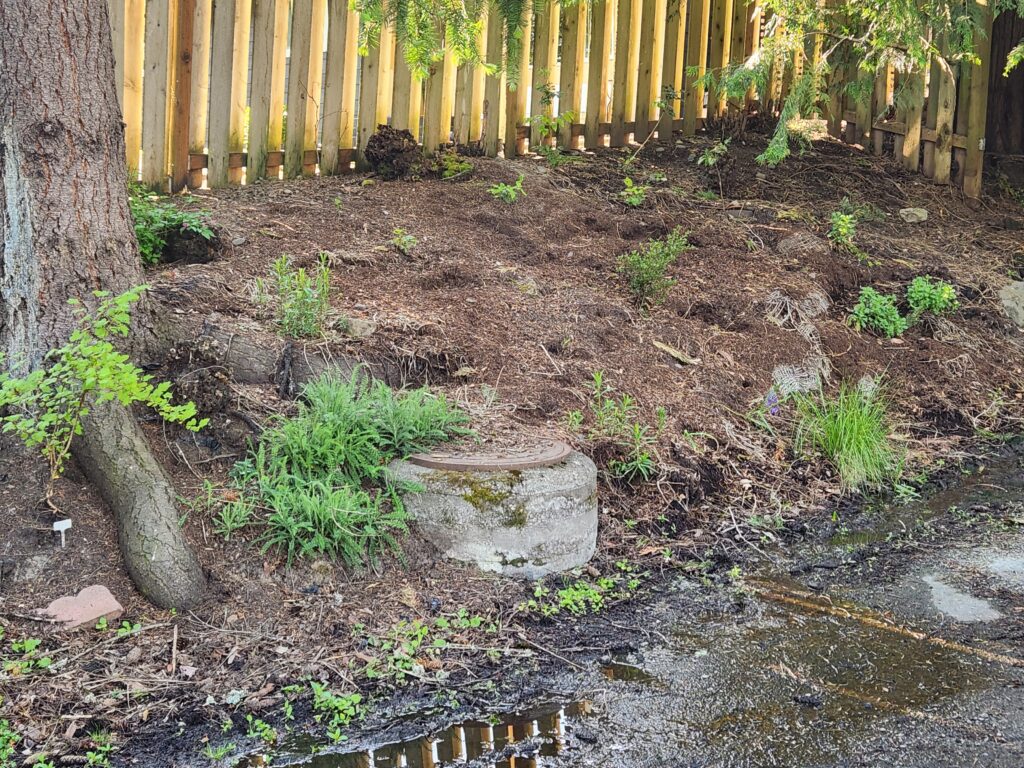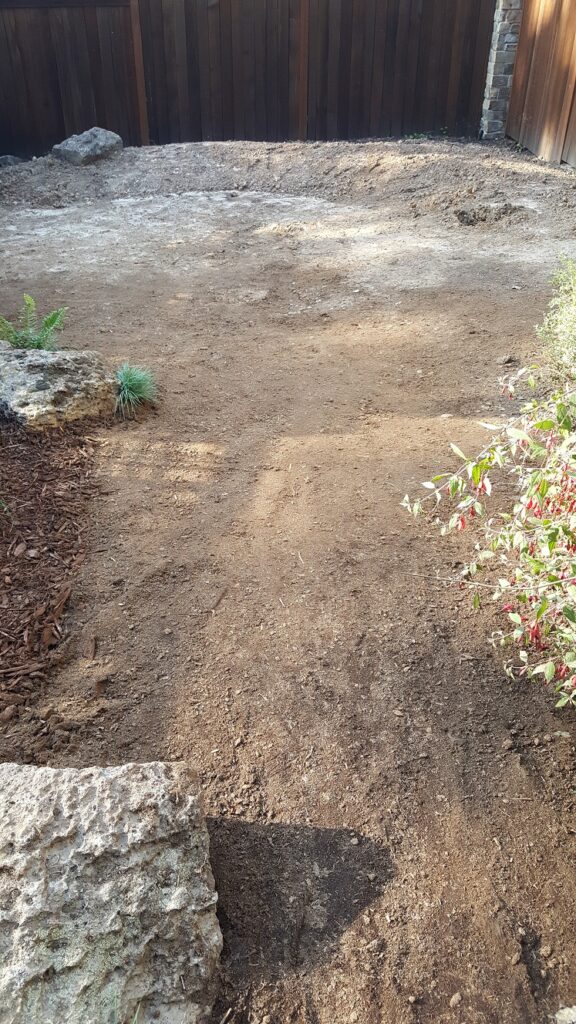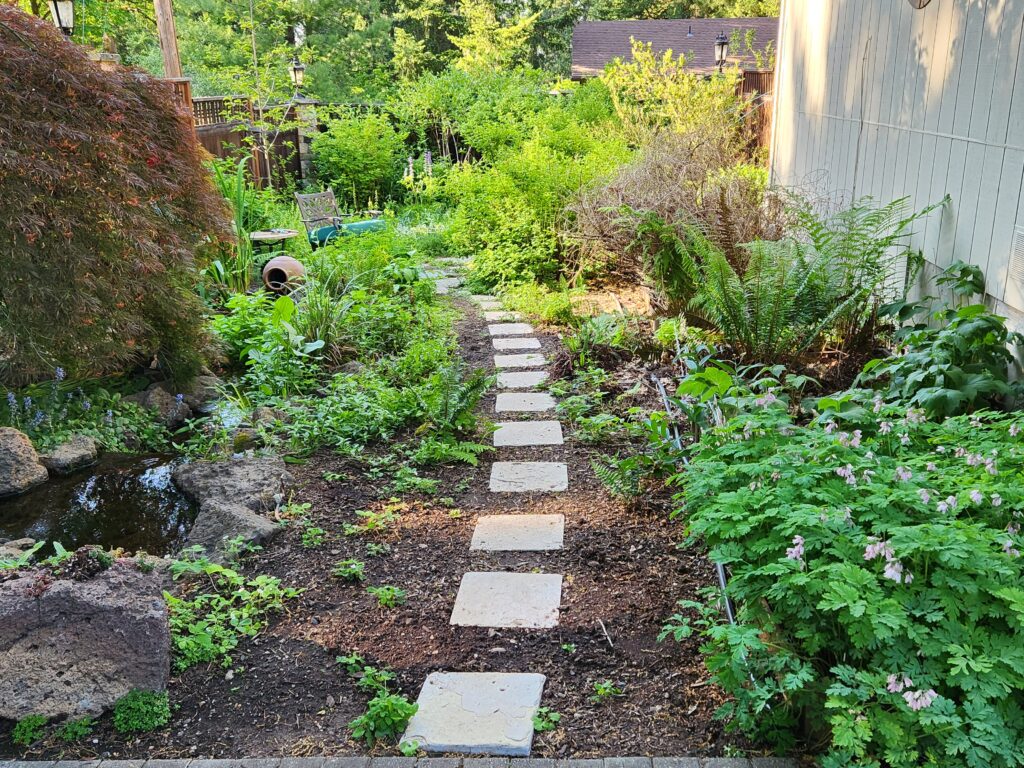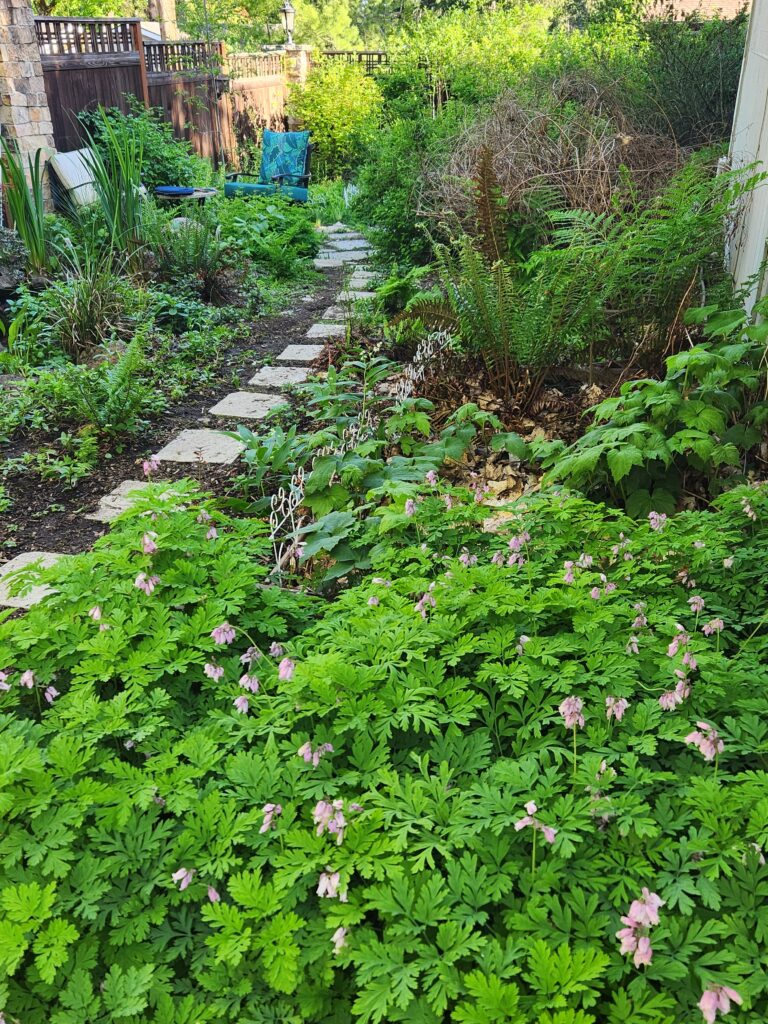Site Information: This habitat in the Garden Home neighborhood in SW Portland, has full sun, part sun, shade, dry, moist, and slope soil.
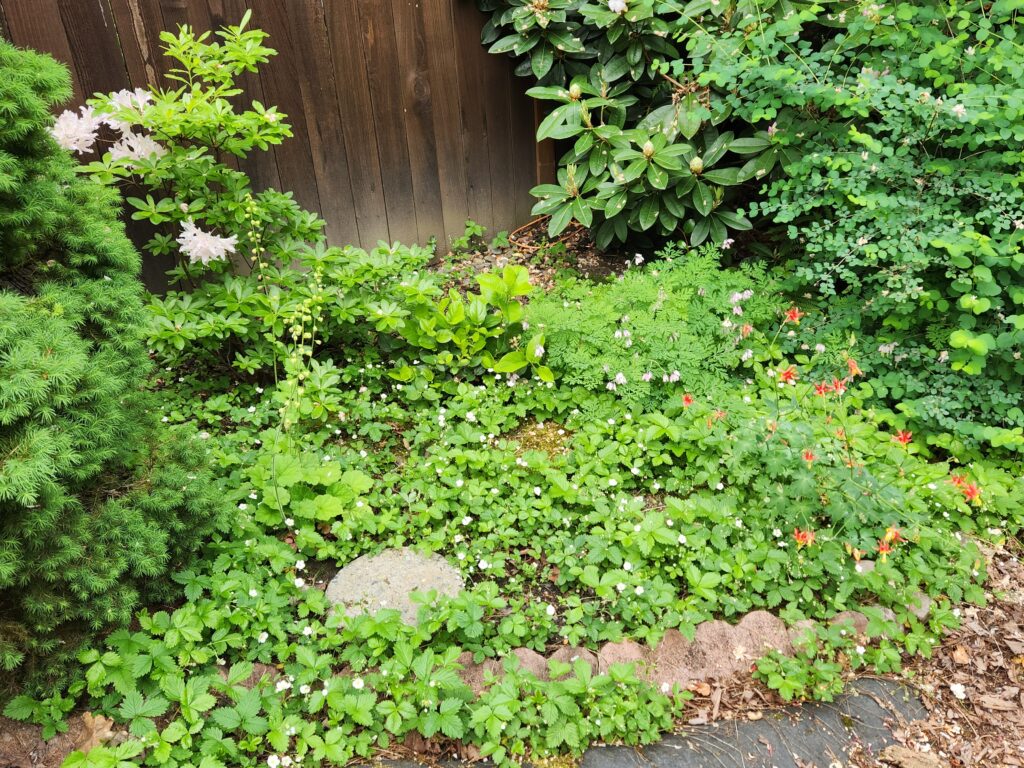
This is actually my favorite spot. It’s in the southeast corner in a mostly shady area and gets gentle morning sun. It fills in beautifully with a Western azalea (on the left, opening up more and more every day right now), columbine, bleeding hearts, salal and snowberries galore, both upright and creeping. Hummingbirds love the snowberry flowers. This area was covered with vinca about 8 inches deep that I planted in 2012 and that I smothered, then pulled out in 2020. That was a job!
What inspired you to enroll in the Backyard Habitat Certification Program?
When walking through our neighborhood, I saw several Backyard Habitat Certification signs. Those yards were the lushest and greenest yards in the neighborhood and I wanted to see what that was all about. I knew nothing about planting with natives at the time but once I read about the program, I wanted to join.
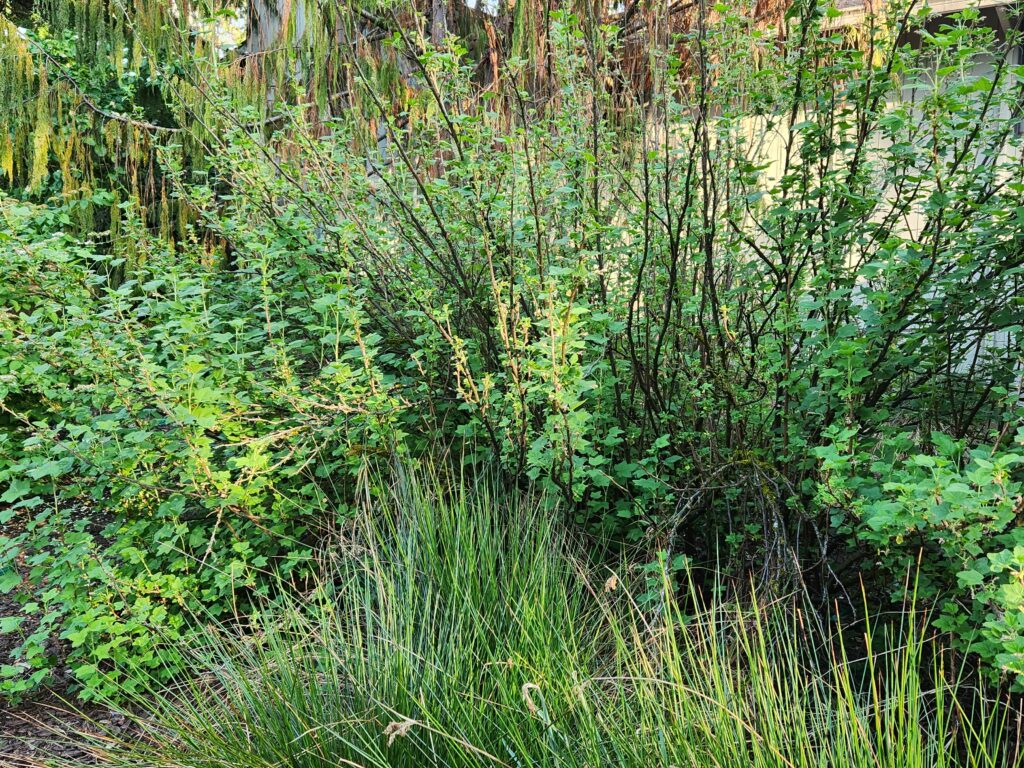
How would you describe your habitat?
My yard includes several different microclimates. Last year, I created a rain garden where an underground spring runs through our property. We’ve had so much rain this winter, there is still water coming up through the driveway even on a sunny day. The rain garden has helped absorb much of that water. I created a small meadow in a full-sun spot in the backyard and filled it with plants to attract pollinators. The plants attract an amazing diversity of native bees now.
There is an underground spring on our property that begins upslope from us and runs downhill onto our lot. The rainier the winter, the more water we have in our yard. Early last spring, I could see through the fence that our neighbor’s backyard lawn (upslope from us) had turned into a small pond. This meant even more water percolating up through our yard and our driveway so I created a rain garden in this very wet, shady spot in April 2022. I planted maidenhair fern (I finally had a place to grow them!), dagger-leaf rush, Pacific waterleaf, fringecup, coltsfoot, trilliums, and ferns, among others.
What are your top three favorite native plants and why do you love them?
Spiraea betulifolia, salal and Pacific waterleaf because they are so uniquely Pacific Northwest and so beautiful. They remind me of parts of Tryon Creek State Natural Area (I used to live on and volunteer in the park) and my vision was to create a small version of that in my yard.
What changes have you observed as a result of creating habitat?
Last year, I found a bird’s nest in one of the snowberry bushes in the yard. I have seen a multitude of birds under the huge (10′ x 10′) red flowering currant including towhees, steller’s jays anting, juncos, sparrows and 2 neighborhood bunnies. This year, I am already seeing a sparrow building a nest behind the vine maple in the back yard.
I planted this currant when it was in a 2-gallon pot. It is literally 10 feet x 10 feet and a favorite of the ground birds. Towhees are always under this bush, sparrows are in its branches and I’ve seen Steller’s jays displaying their “anting” behavior under them.
What were the two most significant challenges you encountered while creating habitat, and how did you address them?
The backyard was mostly gravel and lawn and the sloped part of the front yard was filled with ivy and blackberry. Most of the lot had been covered with black plastic to keep the weeds down. I found an entire coil of copper wire on a spool buried in the yard in one of the most neglected areas. The property adjacent to ours, which I believe is a County easement, was filled with Japanese knotweed, some of which was encroaching on our lot. I have been working with the Tualatin Soil & Water Conservation District for 3 years to get rid of this knotweed. We’re very close to eradicating it and I am now in the process of restoring part of that property (even though it’s not mine). The folks at TSWCD are wonderful to work with and they do this for free!
This is an extra project of mine that is on property adjacent to our lot. I believe it is County easement and has been ignored for 40 years. This spot was covered with ivy and Japanese knotweed, which in turn, was covered with European honeybees. As a result, we had very few native bees in our yard. After working with TSWCD for 3 years, we have almost eradicated it completely. I was finally able to plant this West-facing, mostly sunny area with salmonberry, tall and creeping Oregon grape, goldenrod, beach daisies, yarrow, camas and ceanothus. I can’t wait to see how it looks in a few years.
What resources did you find especially helpful?
I took a class on pollinators offered by the Xerxes Society, the fee for which included a wonderful book called Attracting Native Pollinators. The Meadowscaping Handbook published by West Multnomah Soil & Water Conservation District is wonderful. Eileen Stark’s Real Gardens Grow Natives is my bible. A conversation with Lory Duralia of Bosky Dell Natives gave me the idea of creating a meadow. There are also many great webinars available on Zoom. I recently attended one hosted by the Oregon Native Plant Society about planting for pollinators and insects. The photographs were incredible!
Front of the yard on the other side of our driveway. This has always been a challenging area. It is very dry, ranges from a slight slope to a steep one, is exposed to very hot afternoon sun and is a favorite target for the tires of delivery drivers’ and contractors’ trucks. I am trying to save a Western red-cedar in this area. I have tried many different plants in this area and so far, the goldenrod, wood sorrel, sedum, Pacific waterleaf, monkey flower, and bleeding hearts are faring the best.
How do you enjoy your Backyard Habitat throughout the different seasons? What are its highlights in each season?
We are fortunate to have several mature evergreens on our lot which are beautiful all year round. I have 2 hummingbird feeders so we see Anna’s hummingbirds all winter. I have put out a large moss basket in the yard, I place fur from our dog’s brush in a small clay pot and we have a straw mat on the deck during nesting season. The birds use all of those for nesting materials in the spring. In summer, the meadow is in full bloom and there are many different types of native bees on the flowers. When we removed the lawn we had a waterfall, a stream, and a pond installed; there are dragonflies and damselflies everywhere. In the fall, we enjoy the brilliant reds of the vine maple and Oregon grape. I’ve planted goldenrod which is a late bloomer for the hummingbirds to enjoy when the other flowers are done.
Side of the house (faces North). A gigantic Deodar cedar and an incense cedar form the backdrop. The west trunk of the incense cedar was dying so we had a snag made of it in 2023. The area is a mixture of shade and sun; I’ve planted serviceberry, wax myrtle, beach daisies, red twig dogwood, prairie smoke, Oregon grape, Scouler’s willow, sword ferns, deer ferns, licorice ferns, camas, brodiaea, and wild ginger.
What part of your backyard habitat are you most proud of?
The section of our backyard where we removed the lawn in 2019 and started from scratch. The soil was hard as a rock, there were no signs of life in it at all and we could barely get a shovel into it. We mulched the entire area and planted it that fall. We are fortunate to have a large Northern oak in the backyard that provides leaf litter for the entire back. I scoop up many of those leaves and spread them in the side yard, too. The soil in the back is now black gold and everything we have planted is thriving. My plan was to plant the perimeter of the yard with taller shrubs and a few small trees, with a meadow in the center. I am very pleased with the way it has developed over the last few years. We see so many birds and bees in this spot year-round.
Before: We removed the lawn in the fall of 2019, then covered the dirt with cardboard to kill any weeds. The soil was in poor condition, hard as a rock; I’m not sure even weeds could have grown there.
Is there anything else you’d like to add about your journey?
I have become an advocate for gardening with natives and try to spread the word whenever I can. When new owners bought a house nearby, I stopped by to say hi and one of them told me they were trying to figure out what to do with their front yard, which had been neglected for many years and was filled with ivy. She said they were considering a lawn but the yard was sloped and they didn’t relish the idea of mowing grass on a hill. I suggested planting native plants and mentioned that a lawn was of no benefit to native wildlife. They decided against a lawn! Recently, when I got my most recent COVID booster, the pharmacist was telling me how he had to mow his lawn all the time now that the weather was nice. I suggested that he think about getting rid of his lawn and planting native plants. We talked about it for quite a while and he was very interested in looking into it. I let him know that TSWCD would be happy to help if he elected to do that.
After: Here we are 4 years later.
